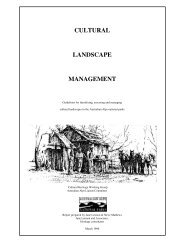Mining Heritage of the Australian Alps - Australian Alps National Parks
Mining Heritage of the Australian Alps - Australian Alps National Parks
Mining Heritage of the Australian Alps - Australian Alps National Parks
You also want an ePaper? Increase the reach of your titles
YUMPU automatically turns print PDFs into web optimized ePapers that Google loves.
• The protection and management <strong>of</strong> historic places should be considered as part <strong>of</strong><br />
<strong>the</strong> plan <strong>of</strong> management process for all categories <strong>of</strong> reserve;<br />
• As historic places occur within all Service areas <strong>the</strong>y are also protected by <strong>the</strong><br />
Service's o<strong>the</strong>r corporate obligations, such as requirement to comply with<br />
government directives regarding asset management &c.<br />
As well as general 'historic places', <strong>the</strong> Act provides for definition <strong>of</strong> Historic Sites as places that can<br />
be gazetted for <strong>the</strong>ir national importance as historic places or monuments. Kiandra would be an<br />
example <strong>of</strong> such an Historic Site within <strong>the</strong> study area.<br />
The 1995 Land Management Regulation establishes that historic heritage can include:<br />
"…. any deposit, object or material evidence relating to <strong>the</strong> settlement or occupation<br />
<strong>of</strong> New South Wales or a part <strong>of</strong> New South Wales (not being Aboriginal settlement<br />
or occupation) where <strong>the</strong> deposit, object or material evidence is more than 25 years<br />
old" (at date <strong>of</strong> interference &c).<br />
<strong>Parks</strong> Victoria:<br />
<strong>Parks</strong> Victoria has management responsibility for <strong>the</strong> natural & cultural heritage that exists within<br />
Victoria's <strong>Parks</strong> system. Within <strong>the</strong>ir stated Purpose, <strong>the</strong>y acknowledge that a prime function is to<br />
conserve, protect and enhance environmental and cultural assets.<br />
Their estate covers approximately 16% <strong>of</strong> Victoria, managed under <strong>the</strong> <strong>Parks</strong> Victoria Act 1998, and a<br />
Management Services Agreement with <strong>the</strong> Secretary <strong>of</strong> <strong>the</strong> Department <strong>of</strong> Natural Resources &<br />
Environment, <strong>the</strong> Minister for Environment & Conservation, and Melbourne <strong>Parks</strong> & Waterways.<br />
<strong>Parks</strong> Victoria manage a large number <strong>of</strong> important conserved & interpreted historic mining sites in<br />
<strong>the</strong> State, but only one within <strong>the</strong> <strong>Alps</strong> <strong>National</strong> <strong>Parks</strong> (Greens Creek Battery).<br />
5.2.3 MANAGEMENT RECOMMENDATIONS<br />
The hand <strong>of</strong> man is visible throughout <strong>the</strong> <strong>Alps</strong>, in former and current grazing areas, historical logging<br />
& sawmilling operations, former townsites, roads, tracks, hydroelectric power infrastructure, skifield<br />
developments, mining sites/areas, etc. <strong>Mining</strong> had a major impact on <strong>the</strong> <strong>Alps</strong>, not so much because<br />
<strong>of</strong> <strong>the</strong> actual area mined, but because <strong>of</strong> <strong>the</strong> intensiveness <strong>of</strong> <strong>the</strong> historic operations. <strong>Mining</strong> brought<br />
large numbers <strong>of</strong> people into <strong>the</strong> <strong>Alps</strong> at a time when <strong>the</strong>y were sparsely settled or unexplored, and<br />
provided considerable impetus to infrastructure development (roads etc), regional supply & service<br />
industries (farming, sawmilling etc), and <strong>the</strong> fledgling towns <strong>of</strong> <strong>the</strong> region.<br />
The sites, mining areas and landscapes left by <strong>the</strong> miners are scattered throughout <strong>the</strong> <strong>Alps</strong> <strong>National</strong><br />
<strong>Parks</strong>. Many are interesting places <strong>of</strong> high cultural significance, and all <strong>of</strong> <strong>the</strong>m bear witness to a way<br />
<strong>of</strong> life that has disappeared.<br />
The management <strong>of</strong> mining cultural heritage places in <strong>the</strong> <strong>Alps</strong> is not an onerous task. These places,<br />
within <strong>the</strong>ir environment, lend <strong>the</strong>mselves to management as ruins, and protection for <strong>the</strong> vast<br />
majority is more a matter <strong>of</strong> ensuring that <strong>the</strong>y are not unwittingly exposed to non-environmental<br />
damaging influences, than costly interventions in <strong>the</strong>ir actual materials (fabric).<br />
Management <strong>of</strong> <strong>the</strong> vast majority <strong>of</strong> mining sites/areas as ruins, however, does not sanction wholesale<br />
decision making. That is, sites and landscapes should be assessed individually for values that may<br />
require special management, and only in <strong>the</strong> absence <strong>of</strong> such values should a decision to manage as a<br />
ruin be made.<br />
35

















